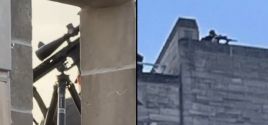Robot Armies: Launching a new kind of warfareRobot vehicles are increasingly taking a role on the battlefield - but their deployment raises moral and philosophical as well as technical questionsPete Warren The Guardian Oct. 28, 2006 |
Popular 
ADL Urged Congress to Pass FISA Law Spying on Americans to 'Protect Israel'

Rep. Thomas Massie Warns Congress is Trying to Pass Hate Speech Laws to Outlaw Criticism of Israel

'Sniper Seen on Roof Overlooking Pro-Palestine Protest' at Indiana University

Mike Johnson Pushes Debunked Lie That Israeli Babies Were 'Cooked in Ovens' On October 7

Claim Jewish Student Was 'Stabbed In The Eye' by Pro-Palestine Protester Draws Mockery After Video Released
 In November 2004, during the second battle of Fallujah, an American uncrewed aerial vehicle (UAV) - a robot plane - located a mortar battery that had been hampering the US operation to retake the town.The mortar's position was logged by the UAV's operator, who was sitting at his desk in Nellis Air Force base near Las Vegas, thousands of miles away. Using the internet, the operator contacted the operator of another armed UAV at a desk in central command ("Centcom") - a safe area away from the theatre of war, with centres in Kuwait, Qutar or Iraq. The two operators swapped information on the mortar in a secure internet chat room, guiding the armed drone to its position to destroy the mortar and its crew. According to Lieutenant General John Sattler, commander of the coalition forces at the battle, it was a proving ground for the use of remote vehicles. "We learned that UAVs can provide the coordinates required for artillery as well as aviation [targeting]. Our UAVs gave us the grid coordinates of an enemy position and allowed us to clear the area for fires and estimate collateral damage," says Sattler. The new remote-controlled technology was also tested in 2001 in the Tora Bora caves in Afghanistan, close to the Pakistan border, believed to be the last stronghold for Osama bin Laden and al-Qaida fighters. Sending soldiers into the caves to try to capture fighters inside would carry huge risks. Instead, the US sent in armed Talon reconnaissance drones - small tanks equipped with camera and sensing equipment, and armed with anything from a sniper's rifle to rocket launchers. They were used to identify caves and positions held by al-Qaida. Information gleaned from the Talons was used to direct what rapidly became a mopping-up operation - although bin Laden was not caught. But that is only the beginning. By 2015, the US Department of Defense plans that one third of its fighting strength will be composed of robots, part of a $127bn (£68bn) project known as Future Combat Systems (FCS), a transformation that is part of the largest technology project in American history. The US army has already developed around 20 remotely controlled Unmanned Ground Systems that can be controlled by a laptop from around a mile away, and the US Navy and US Air Force are working on a similar number of systems with varying ranges. According to a US general quoted in the US Army's Joint Robotics Program Master Plan (http://tinyurl.com/yl7s52), "what we're doing with unmanned ground and air vehicles is really bringing movies like Star Wars to reality". The US military has 2,500 uncrewed systems deployed in conflicts around the world. But is it Star Wars or I, Robot that the US is bringing to reality? By 2035, the plan is for the first completely autonomous robot soldiers to stride on to the battlefield. The US is not alone. Around the globe, 32 countries are now working on the development of uncrewed systems. In the UK, Qinetiq, the former Defence Research Agency which owns Foster-Miller, manufacturers of the Talon system, confirmed that it has developed remote bulldozers and earthmovers and that its technology could also be installed in tanks - and scientists at Qinetiq told the Guardian two years ago that it had built a robot fighter plane. When flown on test flights, they said, the fighter is accompanied by two crewed fighters, whose role is to shoot it down if it malfunctions. Among the 37 or so UAVs detailed in the "US Unmanned Aircraft Systems Roadmap 2005-2030" (http://tinyurl.com/ozv78), two projects demonstrated in 2004 - the Boeing X45a and the Northrop Grumman X47a (both uncannily similar to the Stealth fighter) - are listed as Joint Unmanned Combat Air Systems. A similar project, the Cormorant, which can be launched from a submerged submarine, can be used by special forces for ground support. A close reading of the UAV Systems Roadmap shows the startling progress the US has already made in this field, with systems ranging from fighters to helicopters and propeller driven missiles called Long Guns on display. Ethical debate But if this is the beginning of the end of humanity's presence on the battlefield, it merits an ethical debate that the military and its weapons designers are shying away from. Neither of the documents detailing the US military robot plans, for example, mentions the Geneva Convention which sets out the treatment in wartime of the sick, wounded, civilians and prisoners. Reacting to claims that the deployment of the Talon systems in Iraq and Afghanistan was not fair, Foster-Miller replied that the war on terror was not a fair fight anyway. "These robots will continue to evolve," says Bob Quinn, general manager at Foster-Miller. "The concept now is to introduce a range of human sensors, so that we can convey the impression to the operator that they are actually there, so that they can talk, smell and see. The thinking is that it is very important to have people involved in the loop." In the fog of battle, some UAVs have already fired on their own side. With the increasing likelihood of more autonomous systems being deployed, some US generals have also raised concerns about the reliability of software and its vulnerability to hacking and viruses, pointing out that a rogue robot could inflict considerable damage on humans on its own side in a battle. For the FCS project is far more than the use of robots. It also involves the creation of a hugely complex, distributed mobile computer network on to a battlefield with huge numbers of drones supplying nodes and communication points in an environment under continual attack. For the military, a hacker taking over any part of the FCS is its worst nightmare - and a prospect the US has actively examined. In the mid-90s, hackers from the US Air Force Information Warfare Centre managed to take over the cruise missile system on a US Navy missile frigate, and stray mentions of other covert hacking operations occasionally surface in US military publications. In 1999, one US military source told Aviation Week and Space Technology that "Air Combat Command has been conducting a lot of information warfare activity. By that I mean getting into their computer system and screwing it up. We're trying to use that capability. By getting into the microwave net, you can insert viruses and deceptive computer communications." It's a technique that other US soldiers say was honed against the Serbians during the recent conflicts in the Balkans: "False messages and targets were injected into Yugoslavia's complex computer integrated air defence system." In fact, cyberspace has been a recognised domain for war by the Air Force since last December; and next month Air Force commanders will meet in Washington to discuss the development of a Cyber Command to "deliver sovereign options for the defense of the United States and its global interests - to fly and fight in air, space and cyberspace." But for generals seeking the certainty of destruction, hacking isn't enough. They want a more concrete back-up; as a result work is now been carried out on futuristic microwave weapons including High Emission Radio Frequency guns, which can knock out individual systems, and the Electromagnetic Pulse, which can be used to knock out a country's electronic infrastructure. That could take the debate into much deeper territory, says Peter Zimmerman, professor of science and security at the Department of War Studies at King's College in London. "Sir Arthur C Clarke once wrote a short story about a group of scientists who built a galaxy-wide computer and then asked it whether there was a God," Zimmerman recalls. "The computer fused its power supply into the 'on' position and then told them: 'there is now' - and that's the question that we really need to be thinking about with these systems." However, the Pentagon is not keen to address the problem, says John Pike, director of global security and spokesman for the Federation of American Scientists. "There is a difference between soldiers and soldiers in the movies. On the battlefield, half of the soldiers don't aim their weapons at people because they don't want to hurt them or they don't want to give them cause to hurt them. The robots that are under development can sense, direct and fire dispassionately and are being pointed by people who don't have to worry about being shot at." The introduction of robot forces, he says, "is raising some very difficult issues that the DoD has not thought through, and those are about hearts and minds. Warfare until now has been about the sacrifice of blood or treasure and the US has chosen to sacrifice treasure to avoid body bags." The Pentagon declined to answer questions about the issues raised by the use of robots, saying that the department would "be happy to discuss particular weapons systems under development rather than theoretical issues". But Peter Singer, director of the 21st Century Defense Initiative at the Brookings Institute, who is an expert on FCS, says that the DoD and other states developing robots will have to address the issue in time. "At the moment we have cubicle warriors sitting a long way away from the action, and in the future we will have completely robot systems," he says. "How the use of those will be reported on al-Jazeera will be interesting to see. "I think we will see people in al-Qaida pointing out that these are people too cowardly to fight out in the open. In the event of a robot system destroying a hospital in a situation similar to the cruise missile strike in Baghdad, the reaction will be more than interesting. This is a very historic period; we are now determining who will fight wars in the future and how we will fight them. The human monopoly on war is being broken. Science fiction has now become science reality and we are changing the rules of the game. It's something we have to discuss and it's better we talk now than afterwards." Even though the Pentagon does not want to talk just now, the introduction of robots has already begun one upheaval: a re-evaluation of how it awards medals. After all, should robots' operators receive combat service medals for battles at which they were not physically present? |



